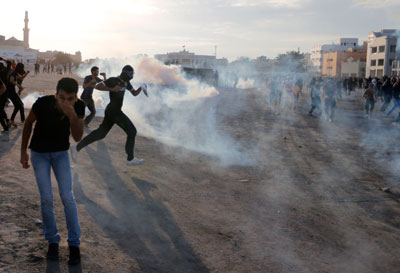Thursday, the official Bahrain News Agency announced the “final 30-day countdown [to] the Formula One extravaganza” to take place the first week of April. Every year the race acts as a lightning rod for criticism of the Bahraini government, which seeks to use high-profile international events like the F1 to gloss over human rights violations in the country.
So perhaps it’s all too predictable that another journalist was arrested in Bahrain only a few hours before the BNA article went to press. Freelance photojournalist Sayed Baqer Al-Kamil was arrested at a checkpoint west of Manama sometime in the early morning hours, according to news reports and his colleagues. It is not clear why he was arrested, but Al-Kamil has meticulously documented the protest movement in Bahrain.
In another recent case, Bahraini security forces arrested photographer Sayed Ahmed Al-Mosawi and his brother in a house raid the morning of February 10, according to news reports. Al-Mosawi was transferred to the Dry Dock prison after several days of interrogation about his work. The journalist, who has won international recognition for his photographs, told his family in a phone call from prison that he had been tortured through beatings and electrocution, according to the Bahrain Center for Human Rights.
Al-Kamil and Al-Mosawi join at least three other journalists behind bars in Bahrain, the second worst country in the world for journalists imprisoned per capita, according to CPJ research.
The arrests also come as at least four journalists were injured in street violence, with political tensions simmering around the third anniversary of the February 14, 2011, opposition protests.
On March 3, a photographer for the English-language Gulf Daily News was injured in an explosion targeting three policemen in Daih village, the paper reported. Ebrahim Al Sinan, who was standing 10 meters from the blast, sustained a lung injury and shrapnel wounds. The journalist was taken to Bahrain Defence Force Hospital for treatment. Gulf Daily News‘s Deputy Editor Robert Smith told CPJ that Al Sinan was released from the hospital on March 4.
The blast came as Al Sinan was covering clashes between riot police and protesters from a funeral procession of a Bahraini inmate who died last month in custody. The government said the inmate, Jaffar Al-Durazi, died from complications of sickle cell anemia, but opposition groups said he was subjected to torture and medical negligence.
It is not clear who carried out the attack on the security forces, with at least two groups claiming responsibility on Facebook, according to Bahrain scholar Marc Owen Jones. Bahrain’s major opposition and human rights groups condemned the attack and urged Bahrainis to end the cycle of violence.
In a photograph of the attack captured by EPA photojournalist Mazen Mahdi, riot police grimace from tear gas as one of their comrades lay wounded in the street. A few days prior, on February 26, Mahdi accused the police of aiming deliberately at journalists after he had been shot in the leg by a teargas canister while covering protests in Daih. He was not seriously injured.
Mahdi and other journalists have faced consistent harassment from security forces attempting to limit coverage of opposition demonstrations, according to CPJ research. The independent Bahrain Press Association reported that Associated Press photographer Hassan Jamali has been unable to cover protests since his press credentials were confiscated by security forces on February 12.
Opposition protesters have also attacked journalists they considered biased in favor of the government. Most recently, al-Arabiya journalists Amjad Taha and Mohammed al-Arab were assaulted by rock-throwing demonstrators commemorating the anniversary of the February 14, 2011 protests, the station reported.
None of this is new for Bahrain. In the past three years, CPJ has documented the arrest, torture, assault and sadly even death of journalists. And while the government has been responsible for the majority of press violations, some opposition protesters too have sought to censor journalists with whom they disagree.
Yet the pace of violations seem to be accelerating, especially as the Bahrain government collects more local freelance journalists in its prisons and frustration on the street grows stronger. As Gulf expert Christopher Davidson recently tweeted, “Bahrain looking more tense now than for a long time.” With a political solution no closer, despite repeated rounds of political dialogue since 2011, I fear those tensions will lead to even greater restrictions on the press.
It appears not only F1 cars are racing in circles in Bahrain.
